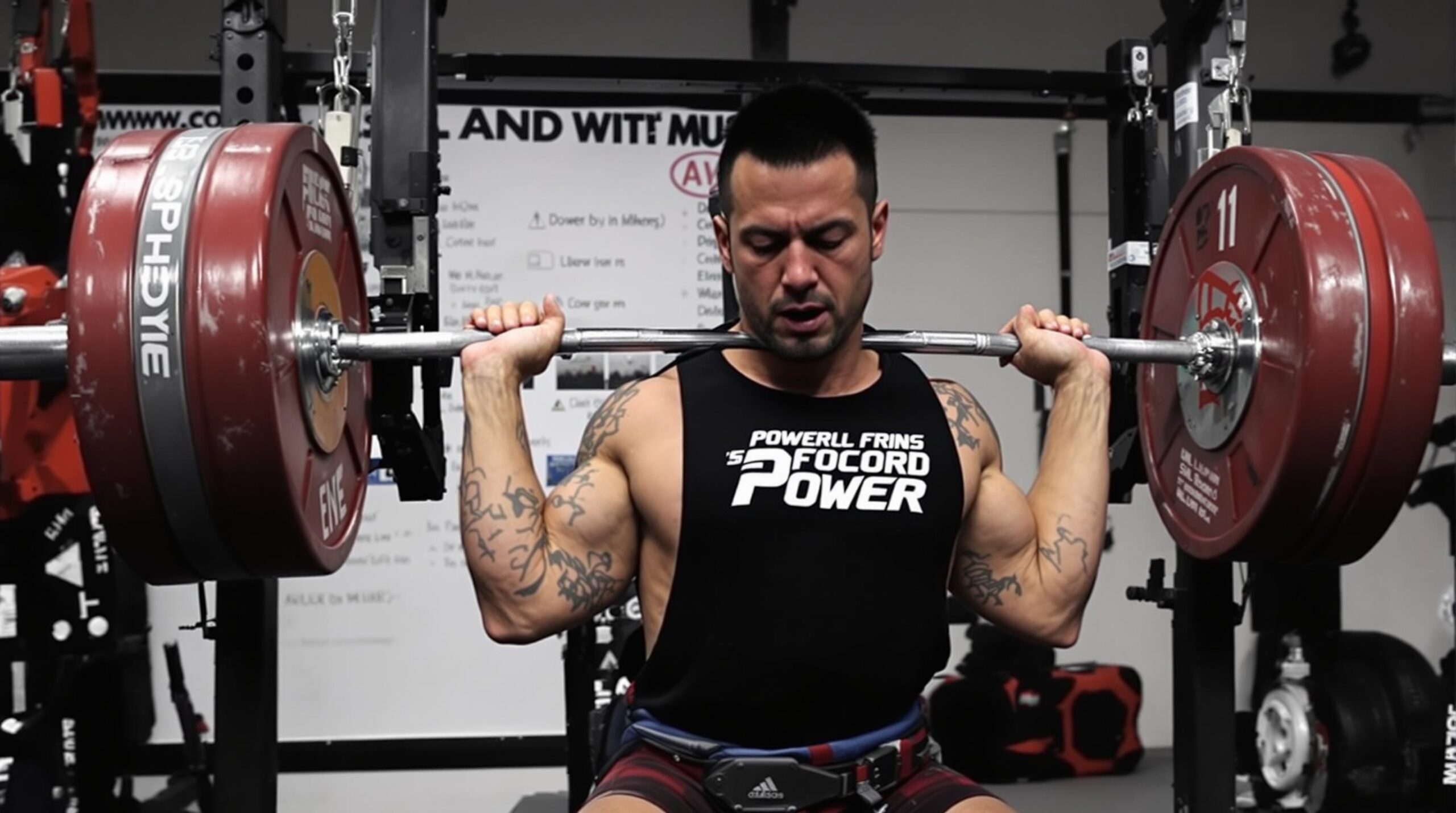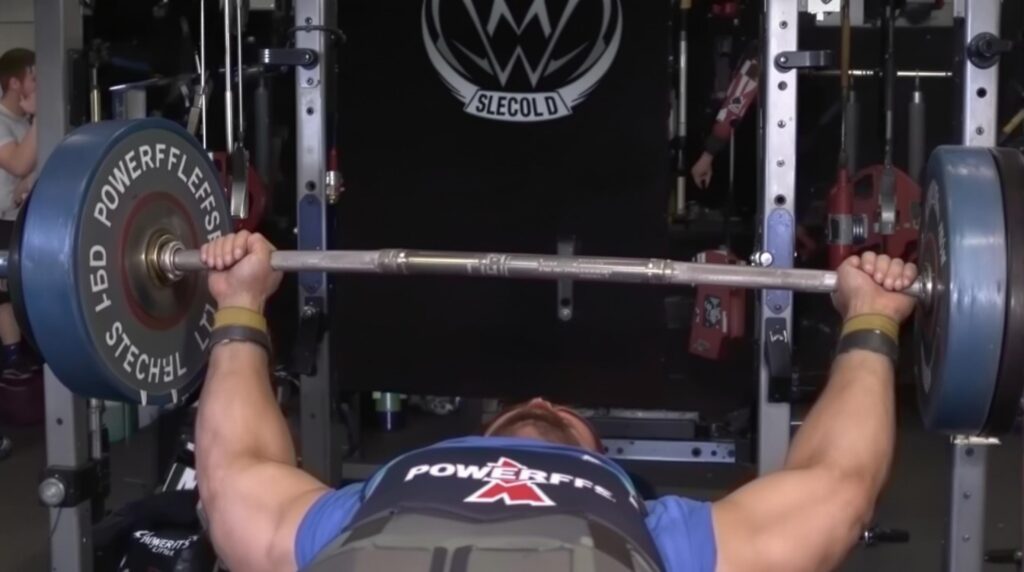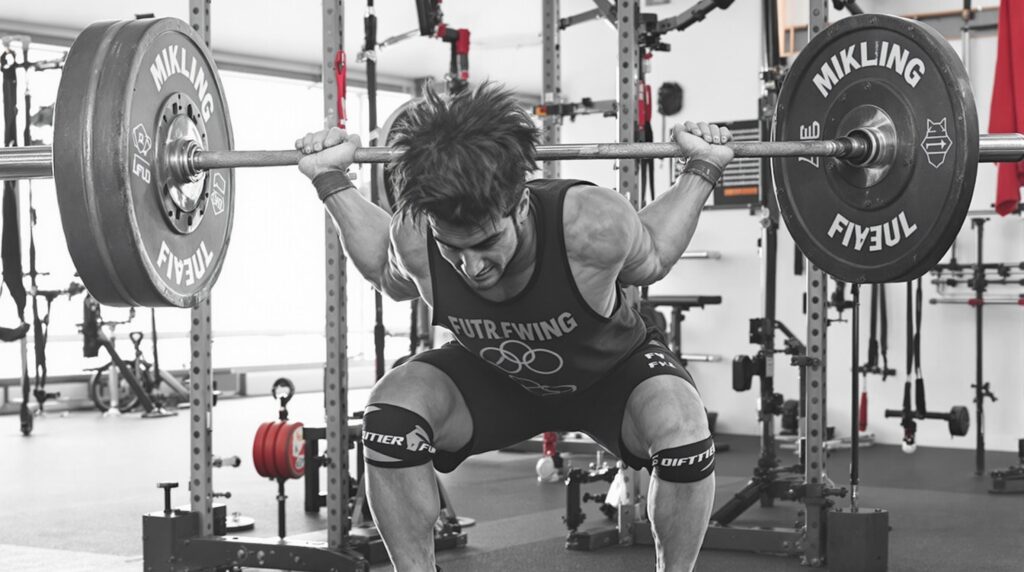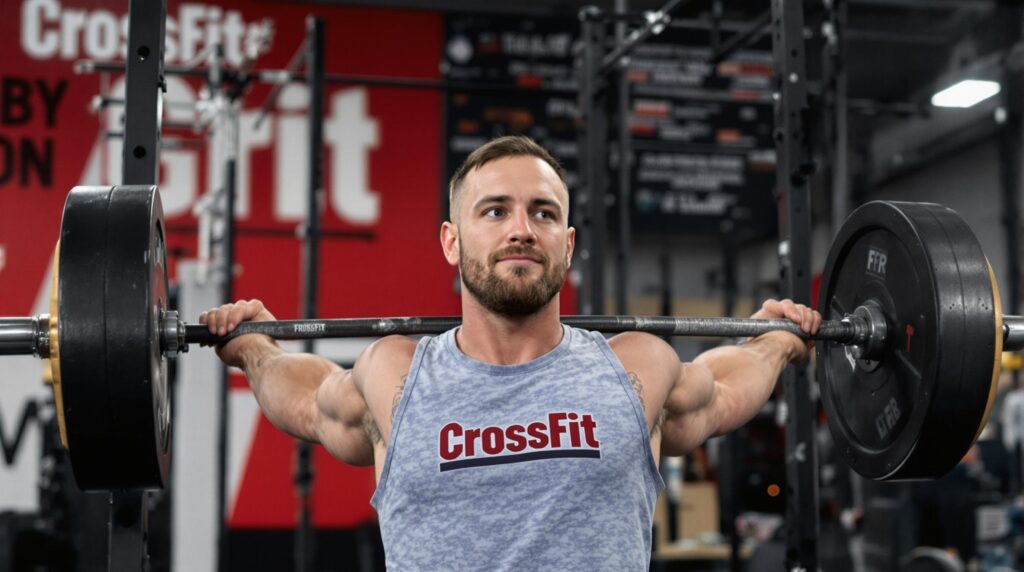The chest press world record represents the pinnacle of human strength potential, combining extreme physical capabilities with advanced training methodologies and mental fortitude. In July 2023, Jimmy Kolb shattered previous benchmarks by successfully pressing an astonishing 635.4 kg (1,401 lbs) in equipped competition, demonstrating that the limits of human strength continue to be pushed further than previously thought possible.
Key Takeaways
- Jimmy Kolb holds the current equipped bench press record at 1,401 pounds, while athletes like Hafþór Björnsson demonstrate impressive raw strength feats
- Elite lifters train with high frequency and specificity, often benching three times weekly with specialized equipment
- Record-breaking strength requires consuming 3,000-4,000 daily calories with at least 200g of protein from quality sources
- Mental preparation techniques like visualization and routine adherence are crucial components of record attempt success
- The distinction between equipped versus raw lifting represents two different approaches to achieving maximum pressing strength
Breaking World Records: The Current Bench Press Giants
The world of competitive powerlifting has witnessed extraordinary feats of strength in recent years. Jimmy Kolb stands as the undisputed king of equipped bench pressing, having set the world record at 635.4 kg (1,401 lbs) in July 2023 at the IPA Tri-Star Bash. This phenomenal lift surpassed his own previous record of 612.5 kg (1,350.3 lbs), showing his continued progression at the highest levels.
In the realm of raw strength, Hafþór Júlíus Björnsson has demonstrated remarkable pressing power. The former Game of Thrones actor holds a raw bench press record of 245 kg (540 lbs) and has performed unique strength demonstrations like a 143 kg (315 lbs) reverse-grip bench press for 25 repetitions. These achievements highlight the different paths to strength mastery that exist in the pressing world.
The distinction between equipped and raw lifting represents a critical differentiation in strength sports. Equipped lifters use supportive gear like specialized bench shirts, which resist descent and provide rebound assistance, enabling significantly heavier loads. Raw lifters compete without such aids, relying solely on their natural strength and technique. Both approaches require immense dedication but employ fundamentally different training methodologies to achieve their respective records.

The Science Behind Elite Pressing: Training Programs That Build Record-Breaking Strength
World-class bench pressers like Kolb follow highly specialized training protocols that maximize their genetic potential. Kolb trains bench press three times weekly, including sessions wearing a bench shirt with weights exceeding his competition goals. This frequency prevents adaptation plateaus and allows for specific skill development with competitive equipment.
The explosive concentric phase proves crucial for record-breaking lifts. Elite pressers prioritize speed off the chest, complementing this focus with targeted triceps development through close-grip bench variations and isometric holds. This emphasis on explosive power translates directly to competition performance, where starting strength often determines success.
Specialized equipment fundamentally alters lifting mechanics. Bench shirts create extreme tension during the descent, storing elastic energy that aids in the pressing phase. They also modify the pressing groove, requiring specific technical adaptations that must be practiced regularly. Mastery of equipped lifting requires equal parts strength and technical skill with the gear.
Functional techniques have also emerged in elite training programs. Athletes like Austin Meadows incorporate hybrid movements such as the hip thrust chest press to integrate explosive hip drive and eccentric overload. These movements develop power throughout the entire kinetic chain, addressing weaknesses that might limit pressing potential.
Fueling the Machine: Nutrition Strategies of World-Class Strength Athletes
Record-breaking strength demands optimal nutrition. Elite pressers typically consume 3,000-4,000 calories daily with at least 200 grams of protein to support recovery and muscle maintenance. Jimmy Kolb emphasizes whole food sources, including raw goat’s milk, grass-fed beef, eggs, and minimal processed carbohydrates, prioritizing nutrient density over convenience.
Strategic pre-competition carb-loading plays a critical role in performance. Many elite lifters consume approximately 2.5 grams of carbohydrates per pound of bodyweight before major lifting sessions, providing the glycogen stores necessary for maximum power output. This practice is often paired with intra-workout nutrition containing fast-digesting carbs, BCAAs, and glutamine to sustain energy levels and begin recovery.
Supplementation strategies for elite pressers typically center around a few proven ergogenic aids:
- Whey protein for rapid post-workout amino acid delivery
- Creatine monohydrate to maximize phosphocreatine stores for power output
- Beta-alanine to buffer lactic acid during high-volume training phases
- Electrolytes and hydration formulas to maintain optimal fluid balance
Nutritional approaches must adapt to the lifter’s age and stage of development. Younger athletes often benefit from higher metabolic rates and nutrient partitioning, while veteran lifters like Jack Maley, who broke records at 66, must address age-related challenges like reduced appetite and slower recovery through more strategic nutrition timing and anti-inflammatory food choices.
The Champion’s Mind: Psychological Preparation for Record Attempts
Mental fortitude separates record holders from mere contenders. Jimmy Kolb employs a powerful visualization technique, summarized in his motto: “If it’s light in your head, it’s light in your hands.” This cognitive approach primes his nervous system for success, creating neural pathways that support the physical execution of seemingly impossible lifts.
Elite lifters often maintain a surprisingly minimal mental approach during competition. When asked about his record-breaking performance, Kolb simply stated, “Today was a good day.” This understated reaction reveals the importance of emotional management during high-pressure situations—avoiding both overexcitement and anxiety that could interfere with performance.
Consistency in routine drives long-term success. Top pressers like Kolb follow rigid training schedules, avoiding deviations that might disrupt their established patterns. This routine-driven focus extends beyond workouts to encompass sleep patterns, meal timing, and recovery practices, creating a holistic system for strength development.
Psychological resilience plays a crucial role during record attempts. Before successfully lifting 1,401 pounds, Kolb missed two previous attempts. The ability to maintain confidence and composure after failures represents a defining characteristic of record-breaking athletes and demonstrates the mental toughness required at the highest levels of strength sport.
Recovery Secrets: How Elite Lifters Prepare Between Training Sessions
Optimal recovery forms the foundation of continued progress. Elite strength athletes typically prioritize 7-8 hours of quality sleep nightly to ensure proper hormone production—particularly growth hormone and testosterone—and adequate tissue repair. This non-negotiable sleep requirement supports both physical recovery and cognitive function.
Strategic “off days” are programmed deliberately, not just taken when fatigue becomes overwhelming. These recovery periods allow for the repair of muscle damage incurred during intense training sessions and prevent the systemic fatigue that can lead to overtraining syndrome. The most successful lifters view recovery as an active, planned component of their program rather than a passive absence of training.
The balance between intensity and adequate rest periods determines long-term progress. Elite lifters carefully monitor their recovery status through various methods:
- Heart rate variability measurements to assess autonomic nervous system readiness
- Performance metrics in warm-up sets to gauge neuromuscular fatigue
- Subjective indicators like perceived exertion and mood state
- Strategic deload weeks incorporated every 4-6 weeks of intense training
Various recovery modalities supplement natural processes. Many top athletes employ contrast therapy (alternating hot and cold), massage therapy, and compression garments to enhance blood flow and reduce inflammation. These techniques accelerate recovery between training sessions and help maintain consistent performance across multiple training days.
Technical Mastery: Critical Form Elements That Maximize Chest Press Performance
Primary movements form the core of any record-breaking pressing program. The flat and incline barbell bench press serve as the foundation for raw strength development, allowing lifters to handle maximal loads with minimal technical limitation. For specialized strength demonstrations, variations like Björnsson’s 213 kg (470 lbs) log press showcase the transferability of pressing strength to different implements.
Precise form cues elevate performance beyond basic strength. Elite coach Jeremy Hoornstra advises lifters to “squeeze the bar to leave finger grooves,” creating maximum tension throughout the upper body. This intentional grip pressure activates the proper muscle firing patterns needed for optimal force production during heavy attempts.
Full-body tension distinguishes elite pressers from novices. Proper engagement of the lats, legs, and core during the descent creates a stable platform for maximum force transfer. This total-body approach transforms the bench press from an isolated upper body movement into a full-system strength expression that recruits maximum muscle mass.
Significant technical differences exist between raw lifting and equipped specialists. Raw lifters typically employ a wider grip with greater scapular retraction, maximizing chest involvement. Equipped lifters like Kolb must adapt to the altered mechanics imposed by bench shirts, using a narrower grip and modified bar path to work with—rather than against—the supportive gear.
Accessory Work: The Supporting Exercises Behind Record-Breaking Bench Press
Triceps development provides the finishing strength needed for record attempts. Close-grip bench press variations and isometric holds at various positions in the range of motion build lockout power for the final phase of the lift. This targeted accessory work addresses the most common point of failure in maximal attempts.
Explosive power development through hybrid movements delivers significant carryover to competition lifts. The hip thrust chest press combines lower body drive with upper body pressing, teaching lifters to generate and transfer force through the kinetic chain—a skill directly applicable to moving maximal loads in competition.
Well-designed accessory work systematically addresses weaknesses in the pressing chain. Common support exercises include:
- Overhead pressing variations for deltoid and upper chest strength
- Row variations to strengthen the antagonist muscles and improve positioning
- Face pulls and external rotation movements for shoulder health and stability
- Board presses and pin presses to target specific ranges within the movement
Elite lifters structure accessory work with careful periodization. Early in training cycles, higher volume accessory work builds muscle mass and corrects imbalances. As competition approaches, volume decreases while intensity increases, with accessory movements selected specifically to enhance competition-specific performance rather than general development.
Equipped vs. Raw Lifting: Understanding the Different Paths to Strength Dominance
Supportive equipment fundamentally transforms the pressing experience. Bench shirts, constructed from multiple layers of canvas or polyester, resist the descent of the bar and provide significant rebound assistance. These specialized garments can ad



